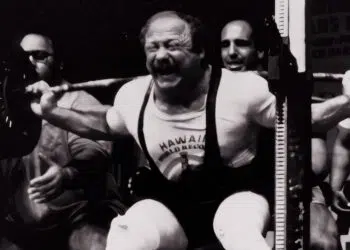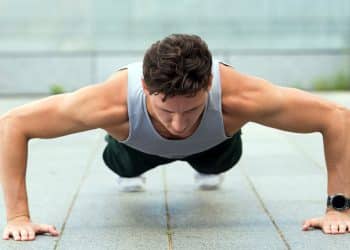The barbell rear delt raise is a unique, underrated shoulder exercise that still deserves a place in your workout routine. It works several muscles of the upper body and is a great option for really loading the muscles that make up the shoulder girdle. Although, its primary purpose is to build the posterior or rear deltoids which play an important role in the roundness of well-developed delts and maintaining good posture.
We put together some useful information on this exercise which includes muscles worked, exercise instructions, variations, and how to include it in your training.
Here’s a guide to the barbell rear delt raise…
Muscles Worked
Check out all of the muscles involved in barbell rear delt raises.
- Biceps Brachii – Help to pull the weight up by flexing the elbow.
- Brachialis – Strong elbow flexor in the forearm and upper arm beneath the outer biceps.
- Brachioradialis – Forearm muscles that aid in grip strength.
- Deltoid posterior – Rear delts engage when the arms are behind the body.
- Levator Scapulae – A muscle in the back that helps elevate the scapula or shoulder blades.
- Trapezius Upper Fibers – Upper trap muscles lift the scapula up during the pull.
- Forearms – Help to maintain form grip and keep the wrists mobile.
Exercise Instructions
The barbell rear delt raise can be an awkward movement compared to common exercises that we do on a daily basis. So, we’ve provided the step-by-step instructions to help you perform it safely and correctly.
Note: we recommend using lighter weights at first to ensure you’re performing the exercise correctly. Then you can increase the poundages as you become more proficient with this exercise.
Level Up Your Fitness: Join our 💪 strong community in Fitness Volt Newsletter. Get daily inspiration, expert-backed workouts, nutrition tips, the latest in strength sports, and the support you need to reach your goals. Subscribe for free!
- Place the barbell on the floor and stand with your heels touching it, feet about hip or shoulder-width apart.
- Bend down and grip the bar with your hands about hip-width apart, palms facing away from you.
- Stand up straight and let the barbell hang down with arms extended. Keep a good posture and you can bend your knees slightly.
- Use your upper rear muscles to pull your elbows up behind your back.
- Extend your arms and repeat.
Here’s a video example of the barbell rear delt raise…
3 Variations of the Barbell Rear Delt Raise
To keep things simple (because this exercise is already awkward enough), we chose three effective variations that you can do.
Read delt reverse barbell raise
This is a must-have variation for building the rear delts. It may be even more challenging but it really hammers the rear delts like no other. Not to mention, you’ll get a little tricep action in there too.
To do this exercise, you want to set up as if you were doing a deadlift while keeping your arms straight. You’ll then raise the bar up behind you and squeeze the rear delts. You should use an empty bar, at least at first. But even as you progress, you’ll still likely not be able to use a lot of weight.
Here’s a great video that shows how it’s done…
Dumbbell rear delt raise
We always have to offer the dumbbell variation just because dumbbells are a must-have training tool. And you can do most exercises using dumbbells that you could with a barbell.
Level Up Your Fitness: Join our 💪 strong community in Fitness Volt Newsletter. Get daily inspiration, expert-backed workouts, nutrition tips, the latest in strength sports, and the support you need to reach your goals. Subscribe for free!
Plus, using dumbbells allows for a free range of movement, different hand positions, and it requires more total body stability, coordination, core activation, and it allows you to identify a potentially weaker side which is actually very common. Go light with the dumbbells, perfect your form, feel the muscles working, and then if you decide you want to step it up, grab the next weight up.
Cable rear delt raise
Can’t have a list of variations and not include cables. The beauty of cables is that there are a variety of attachments that you can use and there’s always tension regardless of body/arm position.
How To Include The Barbell Rear Delt Raise In Your Workout Routine
The rear delts are often a neglected muscle group possibly due to a few reasons. Many times we leave them out because we can’t see them and we forget about them, or we think they receive enough stimulation on back day, or maybe you just don’t care to do a few extra sets for the rear delts.
None of these are good reasons to skimp on rear delt training. In fact, because the rear delts are often underdeveloped and because they are essential to good posture, you can get away with training them a little more than other muscles.
Of course, you don’t want to overtrain them but this isn’t likely to happen for most people. Doing more rear delt work will only benefit you both aesthetically and functionally.
We recommend doing 3 sets of the barbell rear delt raise when you train shoulders, in addition to your other exercises. And, because the rear delts usually don’t get the attention they deserve, you may even benefit from adding in a few extra sets on back day or another training day.
But the most important thing is that you train them directly.
Wrapping Up
The barbell rear delt raise can take your shoulder gains to the next level. You can’t get that cannonball look without developing your rear delts and we think this is an excellent exercise for this purpose.
So, we hope this guide was helpful and now you have enough knowledge to effectively include this movement in your shoulder training regime.
Interested in measuring your progress? Check out our strength standards for Deadlift.








